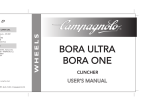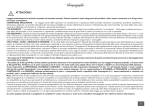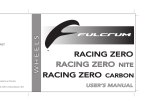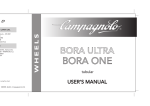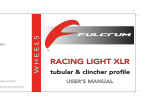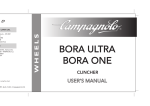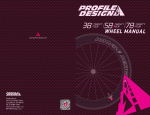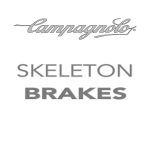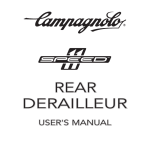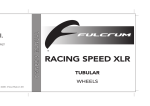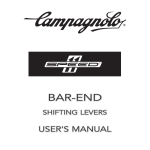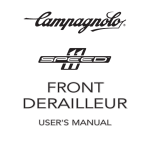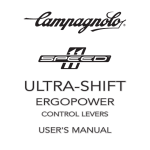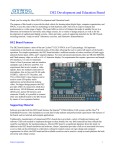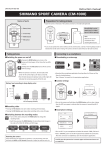Download User manual Bora One tubular wheels
Transcript
D aka-ku - 231-0041 N 2780 30 agnolo.jp D 0th Rd., Nantue Dist. 08 - TAIWAN (R.O.C.) 06831 764 or using the wheel. 7269339 - 06/2014 - © Campagnolo S.r.l. 2014 WHEELS O JAPAN LTD. BORA ULTRA BORA ONE tubular USER’S MANUAL ® WARNING! Carefully read, follow and understand the instructions given in this manual. It is an essential part of the product, and you should keep it in a safe place for future reference. MECHANIC QUALIFICATION - Please be advised that many bicycle service and repair tasks require specialized knowledge, tools and experience. General mechanical aptitude may not be sufficient to properly service or repair your bicycle. If you have any doubt whatsoever regarding your service/repair ability, please take your bicycle to a qualified repair shop. INTENDED USE - This Campagnolo® product is designed and manufactured for use only on road racing style bicycles that are ridden only on smooth road or track surfaces. Any other use of this product, such as off-road or on trails is forbidden. "AN ACCIDENT" - Please note that throughout this manual, reference is made that "an accident" could occur. Any accident could result in damage to your bicycle, its components and, more importantly, could cause you or a bystander to sustain severe personal injury or even death. LIFESPAN - WEAR - INSPECTION REQUIREMENT - The lifespan of Campagnolo® components depends on many factors, such as rider size and riding conditions. Impacts, falls, improper use or harsh use in general may compromise the structural integrity of the components and significantly reduce their lifespan. Some components are also subject to wear over time. Please have your bicycle and its components regularly inspected by a qualified mechanic for any cracks, deformation, signs of fatigue or wear (use of penetrating fluid or other visual enhancers to locate cracks on parts is recommended). Disassembly your bicycle components and especially the pedals, is required during these inspections. If the inspection reveals any deformation, cracks, impact marks or stress marks, no matter how slight, immediately replace the component; components that have experienced excessive wear also need immediate replacement. The frequency of inspection depends on many factors; check with your authorized representative of Campagnolo S.r.l. to select a schedule that is best for you. • If you weigh over 109 kg/240 lbs we advise you not to use this product. Non compliance with this warning can damage the product irreversibly. • If you weigh 82 kg/180 lbs or more, you must be especially vigilant and have your bicycle inspected more frequently (than someone weighing less than 82 kg/180 lbs). Check with your mechanic to discuss whether the wheels you selected are suitable for your use, and to determine the frequency of inspections. The components of Campagnolo® 9s, 10s and 11s transmissions, as well as the brakes, rims, pedals and all other Campagnolo® products are designed as a single integrated system. Not to affect safety, perforWmance, longevity, functionality and the WARRANTY, use exclusively the parts and components supplied or specified by Campagnolo S.r.l., without interfacing or replacing them with products, parts or components manufactured by other companies. Note: Tools supplied by other manufacturers for wheels similar to Campagnolo® wheels may not be compatible with Campagnolo® wheels. Likewise, tools supplied by Campagnolo Wheels S.r.l. may not be compatible with components/wheels supplied by other manufacturers. Always check with your mechanic or the tool manufacturer to insure compatibility before using tools supplied by one manufacturer on components/wheels supplied by another. The user of these Campagnolo® wheels expressly recognizes that there are risks inherent in bicycle riding, including but not limited to the risk that a component of the bicycle can fail, resulting in an accident, personal injury or death. By his purchase and use of these Campagnolo® wheels, the user expressly, voluntarily and knowingly accepts and/or assumes these risks, including but not limited to the risk of passive or active neglicence of Campagnolo S.r.l. or hidden, latent or obvious defects in the product, and agrees to hold of Campagnolo S.r.l. harmless to the fullest extent permitted by law against any resulting damages. If you ever have any questions, please contact your mechanic or your nearest Campagnolo® dealer for additional information. Please note that throughout this manual, reference is made that an accident could occur. Please note that any accident can result in damage to your bicycle and, more importantly, personal injury or, death to you or a bystander. Always follow all warnings and instructions in this manual. 1 SAFETY RECOMMENDATIONS WARNING! Always wear protective gloves and glasses while working on the wheels. DO NOT RIDE YOUR BICYCLE IF IT DOES NOT PASS THIS PRE-RIDE TEST. CORRECT ANY CONDITION BEFORE YOU RIDE! • Never use a bicycle or bicycle component unless you are thoroughly familiar with its use and maintenance history. “Used” equipment may have been misused and abused, and can unexpectedly fail resulting in an accident. • Be sure that your wheels are perfectly centered. Spin the wheels to be sure that they do not wobble up and down or from side to side, and that they do not make contact with the brake pads while rotating. • Be sure that all of the components of your bicycle, including but not limited to your brakes, pedals, handgrips, handlebars, frame and seating system, are in optimum condition and suitable for use. • Be sure that none of the components of bicycle are bent, damaged or out of alignment. • Check to be sure that all quick release fasteners, nuts and bolts are properly adjusted (see the “Quick Release” instruction sheet). Bounce the bicycle on the ground and listen and look for anything which may be loose. • Be sure that your wheels are perfectly centred. Spin the wheels to be sure that they do not wobble up and down or from side to side, and that they do not make contact with the fork legs or brake pads while rotating. • Check all reflectors to make sure that they are clean, straight and securely mounted. • Check you brake pads and cables to be sure they are in good condition. • Test your brakes in the beginning of your ride to make sure that they are operating properly. • Wear clothes which are snug-fitting and which make you visible to traffic, such as neon fluorescent or other bright colors. • Avoid biking at night, because it is more difficult for you to be seen by traffic, and it is more difficult for you to see obstructions on the ground. If you do ride at night, you should equip your bicycle with and use a headlight and a taillight. • Learn and follow the local bicycle laws and regulations, and obey all traffic signals, signs and laws while you ride. • Campagnolo s.r.l. reminds you to always wear a properly fitted and fastened bicycle helmet that has been approved by ANSI or SNELL. 1 - TECHNICAL SPECIFICATIONS 1.1 - WHEEL TECHNICAL SPECIFICATIONS WARNING! THIS WHEEL IS PARTICULARLY DEMANDING FROM AN ATHLETIC POINT OF VIEW. THEREFORE WE RECOMMEND YOU USE IT ONLY AFTER YOU HAVE BECOME EXPERIENCED IN RIDING WITH HIGH PROFILE WHEELS AND A SIDE WIND. 2 Rim: - Bora Ultra H35 mm / H50 mm - Bora One H35 mm / H50 mm 700C (622x17C) O.L.D: front: 100 mm rear: 130 mm Inflation pressure: see the inflation pressure recommended by the producer of the tire. Use: road racing on smooth road or track surfaces only. Rim: Bora Ultra H80 mm 634 mm Only for H50 mm and H80 mm versions Female extension Check what extension you need according to the length of the inner tube valve (if it is necessary to use a female extension) and the height of the rim profile. (OPTION) L UT-WH130F 37 mm UT-WH140F 67 mm UT-WH150F 92 mm UT-WH160F 80 mm L 1.2 - SPOKES TECHNICAL SPECIFICATIONS WARNING! Only use genuine Campagnolo® spokes for your specific type and model of wheel. Failure to use correct spokes can result in an accident, personal injury or death. WARNING! To correctly assess wheel tension a tensiometer must be used: do not go by the tension you feel manually. It is therefore essential to have all the spoke replacement operations carried out by a Campagnolo Pro-Shop, a Campagnolo Service Centre or a mechanic specialised in assembly and maintenance on Campagnolo wheels. The spoke part numbers can be found in the spare parts catalogue which is downloadable from our website www.campagnolo.com. 3 2 - TIRES •The wheel you have purchased is designed to use tubular tires. • Check to insure that the diameter and cross-section of the tubular tire you plan to use are compatible with the dimension of the rim. • The first time the tubular tyre is applied sand the rim with 120 grain sandpaper in order to eliminate the surface polish and degrease only the rim gluing surface with acetone before applying the glue for the installation of the tubular tyre. We recommend using at least 2 coats of glue on the rim and one on the tyre and leaving the glue to dry at least 12 hours between one gluing and the next. Wait at least 24 hours after gluing the tubular tyre before using the wheel. • Ensure that, when high pressure is applied by hand on the tubular tyre, it does not detach from the wheel. • To remove the tubular tyre from the rim, unglue the tubular tyre in an area sufficient to insert a screwdriver between the rim and the tubular tyre; moving the screwdriver along the rim, unglue the tubular tyre (Fig.1). OK! NO! 1.1 1 - Do not remove the tyre off the rim (Fig. 1.1). - after removing the tubular tyre, before gluing the new one, only clean the rim gluing surface with acetone. 2.1 - USE OF INFLATING EXTENSION • In order to ensure correct installation of the tubular tyre, check the tyre manufacturer mounting instructions as well. Unscrew the valve A of the tubular (Fig. 1.2), by using if necessary the provided wrench, and remove the valve (Fig. 1.3). (UT-WH180M for H50 mm versions and UT-HU130 for H80 mm versions) WARNING! • Because of the high temperatures reached when breaking, we recommend you use only glue for tubular tires specifically for carbon fibre rims. • Incorrect mounting of the tyre may cause it to deflate, burst or detach suddenly and cause accidents, physical injuries or even death. • Do not carry out any operation that may create scratches or cuts on the rim or which, in any way whatsoever, may damage it. A damaged rim can break suddenly and cause accidents, physical injuries or even death. A 1.2 4 A 1.3 - Insert the adapter into the small tubes B (Fig. 1.4) and screw it thoroughly by using exclusively the provided wrench C (Fig. 1.5). C B 1.4 • To inflate the tire: remove the cap, unscrew the valve and inflate using a pump with a pressure gauge to obtain the required pressure, then tighten the valve and re-fit the cap. • To deflate the tire: remove the cap, slightly unscrew the valve, then press it until the required pressure is obtained; tighten the valve and re-fit the cap. CAUTION! 1.5 - Insert the valve A into the adapter (Fig. 1.6) and screw it strongly by using exclusively the provided wrench C (Fig. 1.7). A 2.2 - INFLATING AND DEFLATING THE TIRE C Never exceed the maximum inflation pressure recommended by the tire manufacturer. Excessive tire pressure reduces the grip of the tire on the road and increases the risk that the tire will unexpectedly burst. Inflation pressure that is too low reduces tire performance and increases the probability of sudden and unexpected loss of tire pressure. In addition, premature wear and damage to the rim may occur. Note The tire pressure should also be adjusted depending on the weight of the rider; a heavy rider should have a greater tire pressure than a light rider. WARNING! 1.6 1.7 Incorrect tire pressure could cause tire failure or loss of control of the bicycle, resulting in an accident, personal injury or death. - Proceed with inflation of the tubular (follow the instructions on paragraph 2.2). - To deflate the tubular, unscrew the valve and press it against the mechanism inside the adapter. 5 3 - FITTING THE WHEEL ON THE FRAME / USING THE QUICK RELEASE See the “Quick Release” instruction sheet. 4 - SPROCKET ASSEMBLY AND REMOVAL 4.1 - 10s SPROCKETS Refer to the instruction leaflet enclosed with the 10s sprockets for all the assembly, disassembly, use and maintenance operations. ® 4.2 - 11s SPROCKETS of Campagnolo s.r.l. (on FW body for 11s sprockets of Campagnolo s.r.l. ) 4.2.1 - ASSEMBLY 1) The sprockets are pre-assembled and timed on the plastic support (A - Fig. 2). The ring G (Fig. 2) is provided with a preassembled washer (H); ensure that it is positioned as in fig. 2.1. G G 2) Remove the ring (G - Fig.2). 3) Insert the support on the side of the freewheel body, align the spline patterns, press the sprockets onto the freewheel and extract the support (A) from the hub (Fig. 2). H AA 2 6 2.1 4) If installing the sprockets without the plastic support, install the individual or preassembled sprockets and the spacers on the sprocket body of the hub aligning the spline patterns (Fig. 3). The profile of the freewheel body with two asymmetrical grooves (Fig. 3) ensures automatic sprocket timing since there is only one assembly option. D D 40 Nm (35440in.lbs) N.m - 29.5 lb.ft CG 5) Using a torque wrench (D - Fig. 4) equipped with Campagnolo® tool UT-BB080 (B - Fig. 4), tighten the lockring (G - Fig. 4), which is provided with the Campagnolo sprockets, on to the freewheel body to 40 Nm (354 in.lbs). UT -BB080 UT-BB080 BB CLOSE 4 3 4.2.2 - DISASSEMBLY 1) Remove the lockring (G - Fig. 5) using the Campagnolo® tool UT-BB080 (B - Fig. 5) with a 24 mm hexagonal wrench (E - Fig. 5) and the chain whip Campagnolo® UT-CS060 (F - Fig. 5). 2) Insert the plastic sprocket carrier on the side of the freewheel body and align the spline patterns on the body with those on the carrier. Slide the sprockets onto the carrier. G C BB EE UT-BB080 UT-BB080 3) Slide the sprockets, off the freewheel body (Fig. 6). FF UT-CS060 UT-CS060 5 APRIRE OPEN OPEN ÖFFNEN 6 7 4.3 - 9S, 10S, 11S SPROCKETS FROM SHIMANO INC. and SPROCKETS FROM SRAM CORPORATION (on the Campagnolo® freewheel body for Shimano Inc. 9/10/11s sprockets and Sram OG 1070 - OG 1090 sprockets) 4.3.1 - ASSEMBLY AA • SHIMANO INC. SPROCKETS M BB 1) Fit the sprockets on the freewheel body and check that: - the surface with the name of the group of each sprocket is turned to the outside of the freewheel body. - the broadest groove of the sprocket (A – Fig. 7) and the broadest of the freewheel body (B – Fig. 7) are aligned. Important! With the 11s freewheel body, only use the adapter (M - Fig.8) for 9s and 10s sprocket packs by Shimano Inc. and Sram Co. (the adapter must not be used for 11s sprocket packs by Shimano Inc.). The adapter (M - Fig.8) must be fitted on the freewheel body of the 9s or 10s sprocket pack, or on any washer supplied together with the 9s or 10s sprocket pack. See the instruction sheet provided by the sprocket pack manufacturer for installation, removal and maintenance instructions. 2) Using tool TL-LR15 from Shimano Inc. or FR-5 from Park Tool Co. (B - Fig. 9) tighten the lockring (G - Fig. 9) on the freewheel body to 30-50 Nm (266-443 in.lbs). 7 30-50 Nm (266-443 in.lbs) D D C G B B CLOSE 9 8 8 A B 10 • SRAM CORPORATION SPROCKETS 1) The sprockets are preassembled on a support (A - Fig. 10). 2) Insert the support on the side of the freewheel body, align the grooves, press the sprockets onto the freewheel body and extract the support (A) from the hub (Fig. 10). 3) Using tool TL-LR15 from Shimano Inc. or FR-5 from Park Tool Co. (B - Fig. 9) tighten the lockring (G - Fig. 9) on the freewheel body to 30-50 Nm (266-443 in.lbs). 4.3.2 - DISASSEMBLY 1) Remove the lockring (G - Fig. 11) using tool TL-LR15 from Shimano Inc. or FR-5 from Park Tool Co. (B - Fig. 11) and a chain whip (e.g. Shimano Inc. TL-SR20 - D - Fig. 11). 2) Remove the sprockets from the freewheel body (Fig. 12). D D CG BB OPEN 11 12 9 5 - BRAKES Please consult the instruction sheet supplied by the manufacturer. WARNING! F Use only the special red braking blocks with the BORA ULTRA / BORA ONE wheels: • code BR-BO500, for Campagnolo brakes, except for versions that have a locking screw (F - Fig. 11) on the block holders ® • code BR-BO500X, for Dura-Ace brakes from Shimano Inc. and Campagnolo® brakes that have a locking screw (F - Fig. 11) on the block holders. Using any other block-rim combination could cause insufficient and/or irregular braking and could cause accidents, physical injury or death. Using braking blocks other than those specified could also seriously damage the rim. 13 WARNING! When operating on the brake lever, make sure that the two blocks SIMULTANEOUSLY GET IN CONTACT with the rim surfaces. If that is not done, check that your brakes are correctly centred according to the instructions indicated by the brakes manufacturer. 6 - MAINTENANCE Note We recommend that you contact a specialized mechanic for all the assembly, disassembly and all hub, rim and spoke replacement operations. Choose with him the most suitable interval of inspections for you on the basis of the conditions of use and intensity of your activities (e.g. racing, rain, salted roads, muddy roads, cyclist’s weight, etc.). ATTENTION! NOTE FOR SPECIALIZED MECHANICS CONTACT YOUR CAMPAGNOLO® SERVICE CENTER FOR THE INSTRUCTIONS FOR ASSEMBLING, MAINTAINING AND REPLACING RIMS, SPOKES AND HUBS, OR YOUR CAMPAGNOLO DEALER. 10 WARNING! Do never use acetone on the surface of the label when cleaning the rim: these types of labels are extremely light and weather resistant, but are not resistant to acetone and are not replaceable. TYPE OF OPERATION KMS (MAX) Check at a specialized mechanic’s: 2.000-5.000 • check the lubrication, rolling and clearance of the hubs • check the wheel centering Check at a specialized mechanic’s: • check the lubrication, rolling and clearance of the hubs and replace any worn parts of the hubs and free wheel body • check the wheel centering • check the wear of the braking track and replace rim if required 10.000-20.000 • If the hub bearings are CULT (in Cronitect®, advanced solution by FAG and the balls in ceramic), periodically take the bicycle to a specialised mechanic to have the hub bearings and the balls lubricated with specific oil for bearings. • If the hub bearings are USB or Standard, periodically take the bicycle to a specialised mechanic to have the hub bearings and the balls lubricated with specific grease for bearings. •Keep the braking surface of the rim and the brake pads free from oil and grease. • At the end of the lubrication operations, CAREFULLY degrease the braking rim and the brake blocks. • To maintain the brake pads are in efficient working order and to avoid wear on the sides of the rims, you should remove with a file any residue of sand, debris or foreign objects which may become embedded in the brake pads, especially during use in the rain. • When riding in wet conditions, remember that the stopping power of your brakes is greatly reduced and the adherence of the tires to the ground is considerably reduced. This makes it harder to control and stop your bicycle. Extra care is required when riding your bicycle in wet conditions to avoid an accident. An accident could result in severe personal injury or death. 11 • Never make any modifications whatsoever to any component of any Campagnolo® product. • Parts which have been bent or otherwise damaged in an accident or as a result of any other impact must not be re-straightened. They must be replaced immediately with original Campagnolo® parts. • After using the wheel for the first time, check wheel trueness and circularity. WARNING! Using wheels that have not been centred properly or which have broken or damaged spokes may result in accidents, personal injury or death. • Do not expose the carbon wheels to high temperatures. Do not store bike parts in vehicles parked in the sun, and do not store near radiators or other heat sources. Do not store carbon fiber products in direct sunlight. 6.1 - CLEANING THE WHEELS When cleaning the wheels, only use non-aggressive, non-corrosive products such as water and neutral soap, or specific products specially designed for cleaning bicycles. Absolutely never use abrasive or metal sponges. Dry with a soft cloth. NOTE Never spray your bicycle with water under pressure. Pressurized water, even from the nozzle of a small garden hose, can pass seals and enter into your Campagnolo® components, damaging them beyond repair. Wash your bicycle and Campagnolo® components by wiping them down with water and neutral soap. WARNING! Salt water environments (as found on winter roads and near the seaside) can cause galvanic corrosion on most bike parts. Carefully rinse, clean, dry and re-lubricate all exposed parts to avoid damage, malfunctions and accidents. 6.2 - TRANSPORT AND STORAGE When transporting the wheel separately from the bike or if the wheel will not be used for a long period of time, store it in the wheelbag to protect it against impacts and dirt. Campagnolo S.r.l. reserves to modify the content of this manual without notice. The updated version will always be available www.campagnolo.com. Rev00_06_2014 12













